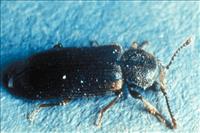
Caption:
Photo by:
|
|
Powderpost beetles
(revision date: 2/27/2014)
Use Integrated Pest Management (IPM) for successful pest management.
Biology
Powderpost beetles, or lyctids, feed on starch in hardwoods, such as oak, cherry, or ash, and they will also feed in bamboo. These insects are usually brought into a home in hardwood flooring, trim, plywood, and wooden articles such as furniture and tool handles. The adult beetle is small, 1/8-3/8 inch long, and is red, brown, or black in color. These adult beetles mate and lay eggs on unfinished wood. The larvae develop and feed within the wood for 8 to 10 months, causing the damage. Powderpost beetle damage is recognized by the powdery frass (excrement) that is produced and falls out of the emergence holes.
|
